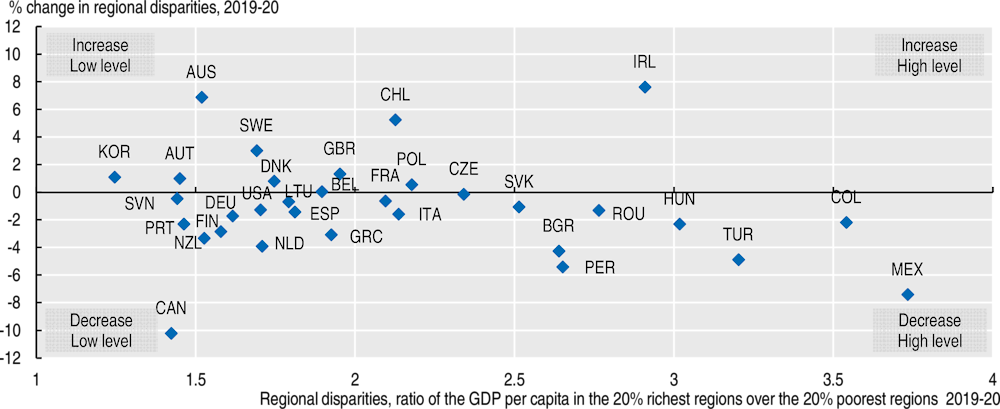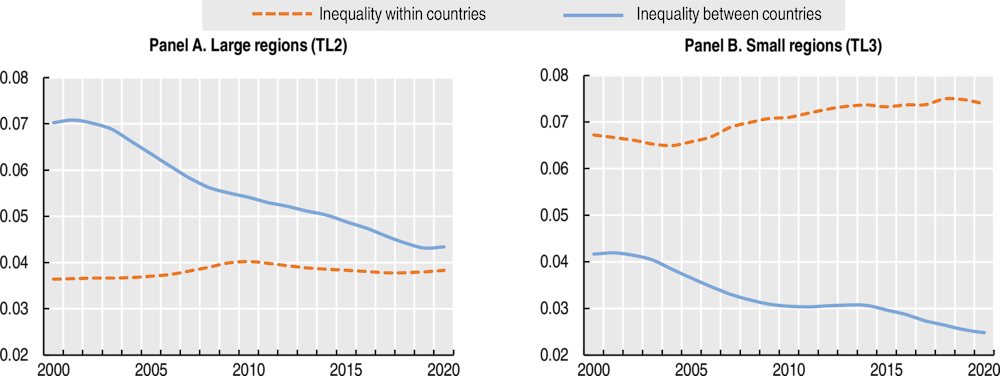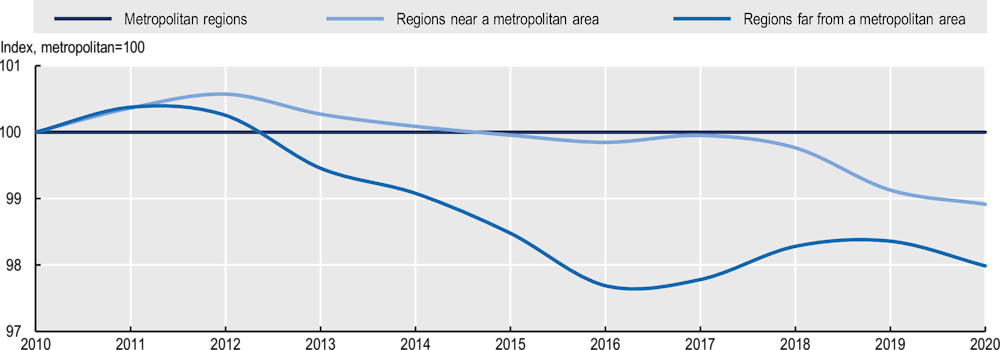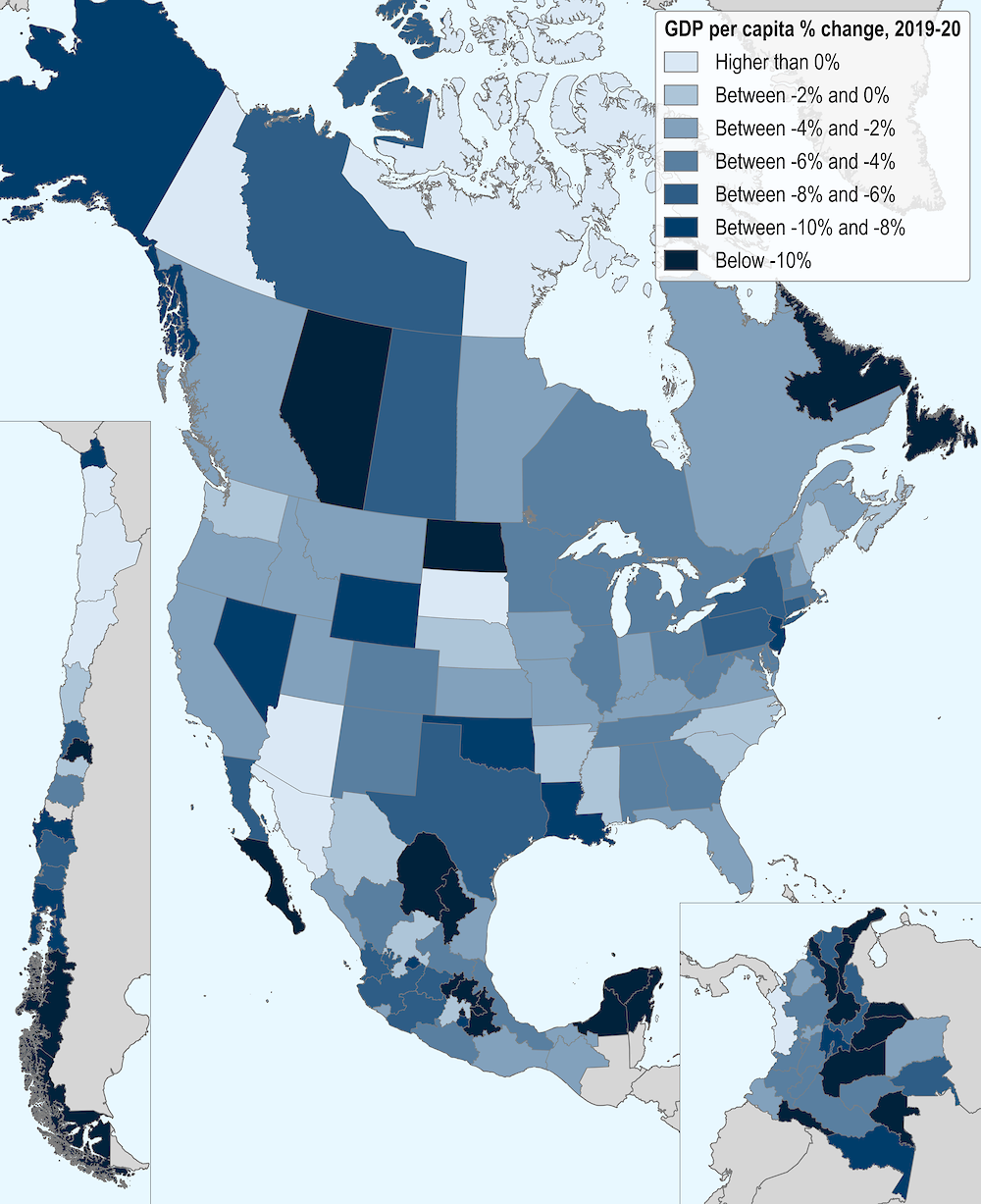Due to COVID-19, GDP in 2020 declined by more than 9% in the worst-hit regions. Over the last decade, non-metropolitan regions – especially those far from cities – continued to lag behind metropolitan regions in terms of GDP per capita.
GDP per capita fell across the vast majority of OECD regions in the first year of the COVID-19 pandemic. The large declines affected all types of regions across the rural-urban continuum: many with higher pre‑pandemic levels of GDP and many others with lower pre-pandemic levels of GDP. Lower global demand, widespread travel bans and other measures to avoid COVID-19 contagion led to GDP declines even in countries and regions that managed to keep COVID-19 cases low. Although the pandemic did not increase regional disparities, the average gap in GDP per capita between metropolitan and non‑metropolitan regions across OECD countries has also not receded over the last decade.
There is still substantial economic polarisation within countries (defined as the ratio of per capita GDP between its top and bottom 20% of regions) but polarisation did not generally worsen during the pandemic. In 2020, GDP per capita in the top 20% of large regions was, on average, twice that of the 20% bottom regions. Overall, half of OECD countries experienced a decrease in economic polarisation from 2010 to 2020 across large regions. The decreases in polarisation have been particularly large in Canada, Mexico, Peru and Türkiye, where there were large declines in 2020. Only 10 out of 33 countries became more polarised in 2020 and, in most of these cases, bottom regions declined more than top regions– especially in Chile, Korea and Sweden. Nevertheless, Mexico and Türkiye – along with Colombia – still show the starkest regional gaps in GDP per capita, whereas Canada and Korea show the smallest (Figure 1.6).
When looking at disparities over the last 20 years, regional inequality in GDP per capita is persistent, especially within OECD countries. These trends are measured by the Theil index of regional GDP per capita – a composite index of inequality within and between countries. Measures of within-country inequality appear to be slightly higher than two decades ago, although their rise was concentrated in 2005‑12 and within-country inequality for large (TL2) and small (TL3) regions has remained roughly constant since then. On the other hand, between-country inequality has steadily declined over the last two decades (Figure 1.7, Panels A and B).
Some of the largest within-country differences in regional GDP per capita are between metropolitan and non-metropolitan regions. Metropolitan regions had both higher initial levels of GDP per capita and faster growth than other types of regions, especially those far from metropolitan areas. The lack of convergence in growth implies large and persistent differences between rural and urban areas. Non-metropolitan regions near metropolitan ones kept pace with metropolitan regions from 2010-18 but grew at a slower pace afterwards (Figure 1.8) whereas regions far from metropolitan areas fell further behind metropolitan regions, especially from 2012-16.
In 2020, GDP per capita declined by 5% in the median region, 2% in the top 20% of regions and 9% in the hardest-hit regions. There were only a handful of regions with positive changes (Figures 1.9 and 1.10). Within countries, the median range across large (TL2) regions was 7 pp. Canada, Colombia and Türkiye had the largest ranges of outcomes in 2020 (all 3 countries had more than 30 pp differences in GDP growth rates between their top and bottom regions). At present, 2020 GDP data for small (TL3) regions are only available for 17 OECD countries. Based on this data, the distribution of 2019-20 percentage changes appear similar across metropolitan and non-metropolitan regions, although the variance is higher for non‑metropolitan regions as some of them experienced more extreme positive and negative changes in 2020 compared to metropolitan regions in OECD countries.
Annual changes in 2020 mask substantial quarterly fluctuations because the pandemic generally had larger negative impacts on 2020 Q2 than other quarters. While annual GDP data show rebounds for most countries in 2021, regional data are not yet available. Moreover, some countries that managed to keep COVID-19 transmission low in 2020 (e.g. Australia, Japan) had more infections in 2021-22. Beyond 2021, substantial uncertainty remains about the future trajectory of GDP across OECD regions due to the longer-term impacts of the COVID-19 pandemic and the rise in energy prices following Russia’s invasion of Ukraine.





